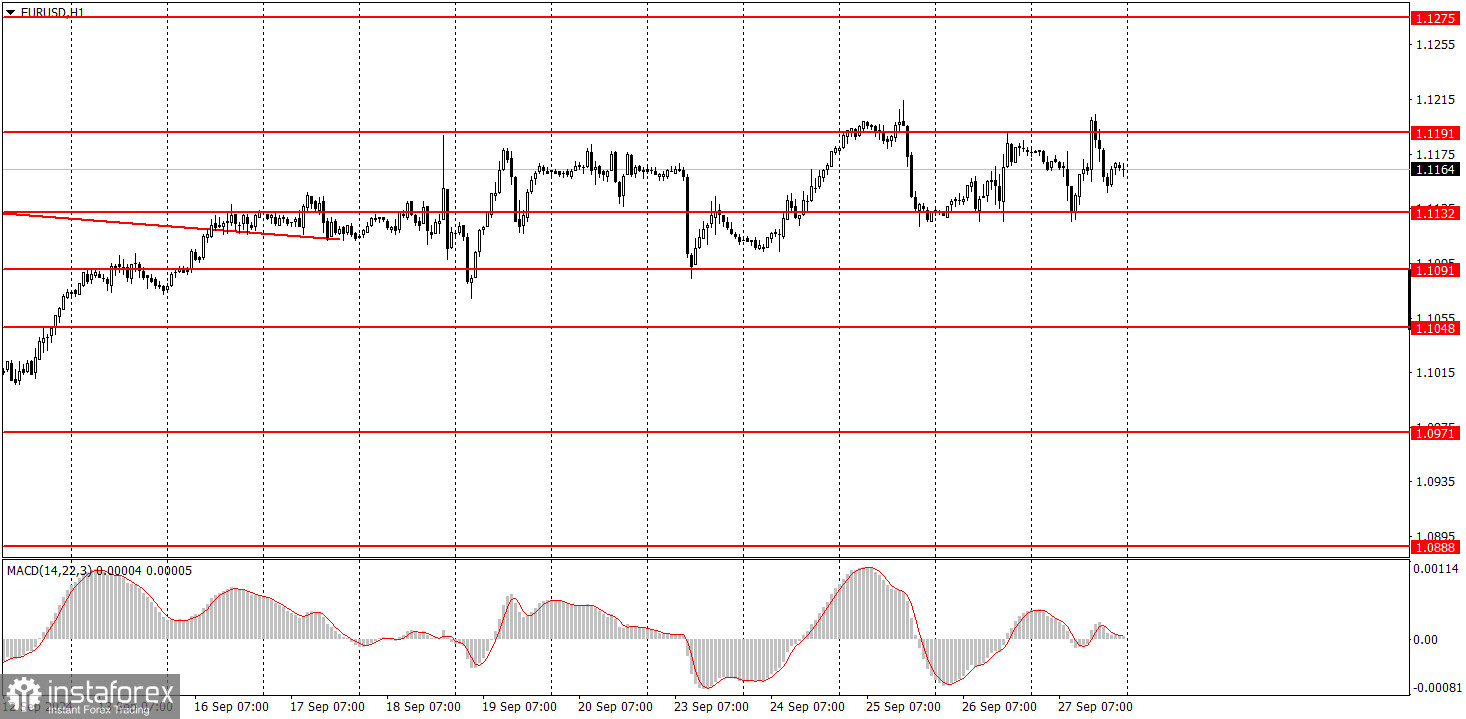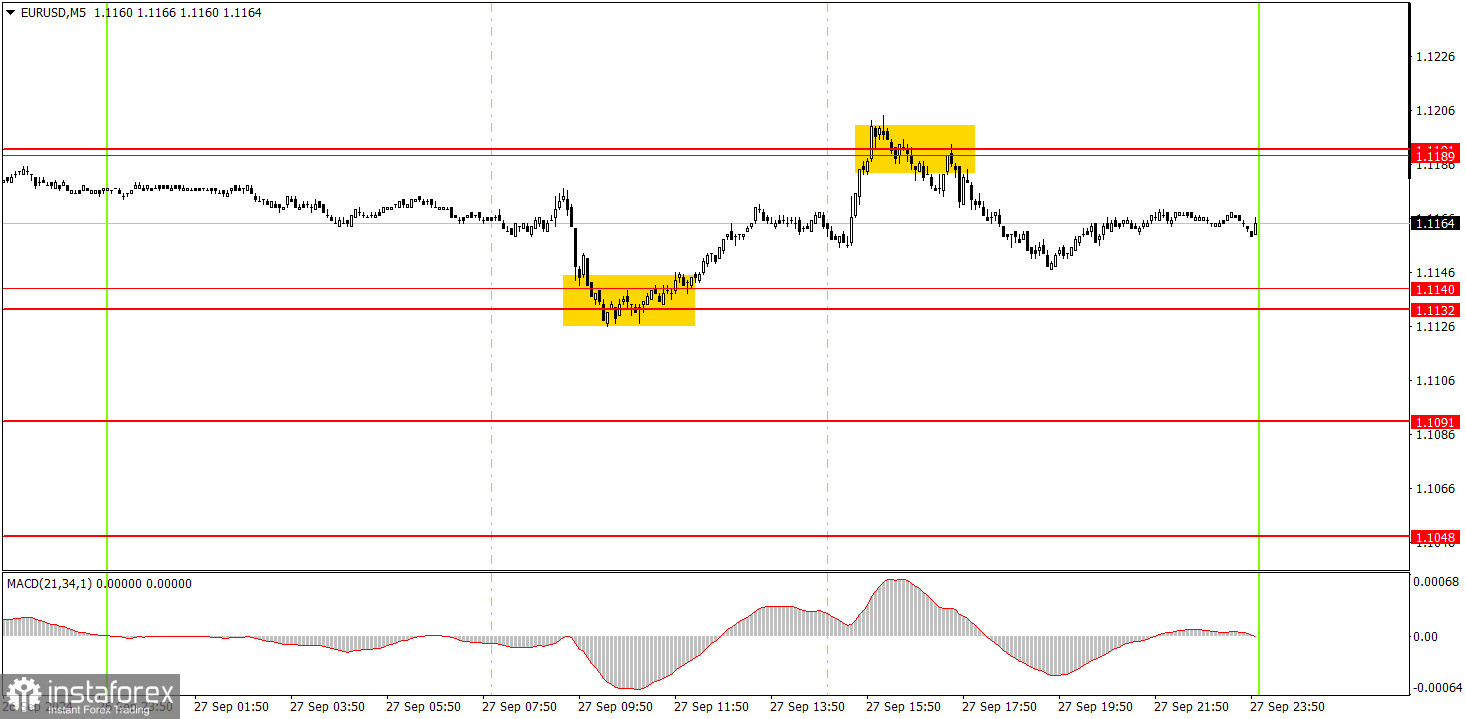Analysis of Friday's Trades:
EUR/USD on 1H Chart

The EUR/USD currency pair gravitated toward growth again on Friday. However, we can characterize the pair's movement over the past few weeks as sideways. This is quite evident even to the naked eye. Most of the time, the price is between 1.1091 and 1.1191. A slight upward slope indicates that the market has not given up on its desire to buy the euro and sell the dollar. But at this stage, we can at least say that the upward movement has paused.
Of course, this upward movement could quickly resume as early as next week. The bulls continue to push even on days when everything points to strengthening the US currency. A clear example of this was Thursday when two important reports in the US turned out to be stronger than expected, yet the US currency still fell by the end of the day. In the new week, we are set to see a whole package of crucial data from the US, so another drop in the dollar is quite likely.
EUR/USD on 5M Chart

Two trading signals were formed in the 5-minute time frame on Friday. During the European trading session, the price bounced off the 1.1132-1.1140 area; in the US session, it rose to the 1.1189-1.1191 area and bounced off it. By the end of the day, the pair almost returned to the area from which it had started its latest growth cycle. Thus, novice traders could open both a long and a short position, each bringing in about 20-30 pips.
How to Trade on Monday:
In the hourly time frame, the EUR/USD pair still has chances to form a downward trend, but these chances continue to fade before our eyes under the constant pressure from the bulls. Unfortunately, the illogical selling of the dollar could easily continue in the medium term since no one knows how long the market will keep pricing in the Federal Reserve's monetary policy easing and ignoring all factors favoring the dollar. Over the past couple of weeks, it has become clear that market participants are finding it difficult to push the pair further upward. We might be close to the end of the uptrend, but important US data are expected in the new week.
For Monday's trading, the potential range is from the 1.1132-1.1140 area, which is roughly in the middle of the 1.1091-1.1191 horizontal channel.
In the 5-minute time frame, the following levels should be considered: 1.0726-1.0733, 1.0797-1.0804, 1.0838-1.0856, 1.0888-1.0896, 1.0940, 1.0971, 1.1011, 1.1048, 1.1091, 1.1132-1.1140, 1.1189-1.1191, 1.1275-1.1292. On Monday, Germany will release the first estimate of inflation for September, and new speeches by Christine Lagarde and Jerome Powell will take place during the day. Thus, the dollar is again in danger, as the market tends to interpret any event or report against the dollar.
Basic Rules of the Trading System:
1) Signal Strength: The strength of a signal is determined by the time it takes to form (bounce or break through a level). The less time it takes, the stronger the signal.
2) False Signals: If two or more trades are opened near a certain level based on false signals, all subsequent signals from that level should be ignored.
3) Flat Market: In a flat market, any pair can generate numerous false signals or none at all. In any case, it's better to stop trading at the first signs of a flat market.
4) Trading Timeframe: Trades should be opened between the start of the European session and the middle of the American session, after which they should be closed manually.
5) MACD Indicator Signals: In the hourly time frame, it is preferable to trade based on MACD signals only when there is good volatility and a trend confirmed by a trendline or trend channel.
6) Close Levels: If two levels are located too close to each other (between 5 and 20 pips), they should be considered as a single support or resistance area.
7) Stop Loss: Once the price moves 15 pips in the intended direction, a Stop Loss should be set at the breakeven point.
What's on the Charts:
Support and Resistance Price Levels: These levels serve as targets when opening buy or sell positions. They can also be used as points to set Take Profit levels.
Red Lines: These represent channels or trend lines that display the current trend and indicate the preferred trading direction.
MACD Indicator (14,22,3): The histogram and signal line serve as an auxiliary indicator that can also be used as a source of trading signals.
Important Speeches and Reports (always found in the news calendar) can significantly impact the movement of a currency pair. Therefore, trading should be done with maximum caution during their release, or you may choose to exit the market to avoid a sharp price reversal against the preceding movement.
For Beginners Trading on the Forex Market: It's essential to remember that not every trade will be profitable. Developing a clear strategy and practicing money management is key to achieving long-term success in trading.
 English
English 
 Русский
Русский Bahasa Indonesia
Bahasa Indonesia Bahasa Malay
Bahasa Malay ไทย
ไทย Español
Español Deutsch
Deutsch Български
Български Français
Français Tiếng Việt
Tiếng Việt 中文
中文 বাংলা
বাংলা हिन्दी
हिन्दी Čeština
Čeština Українська
Українська Română
Română

